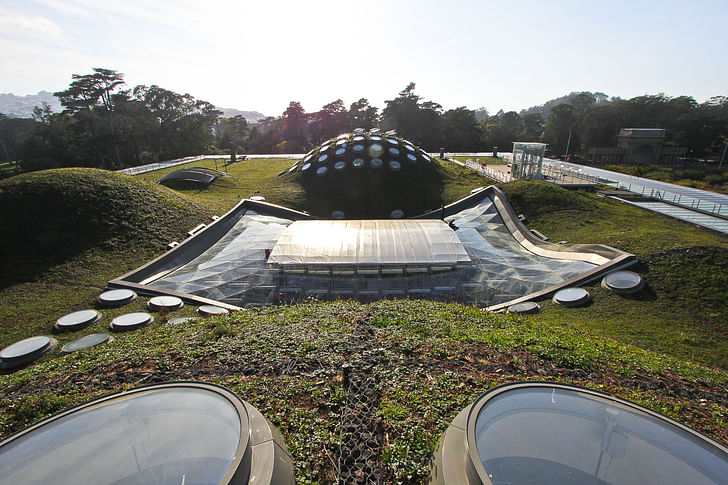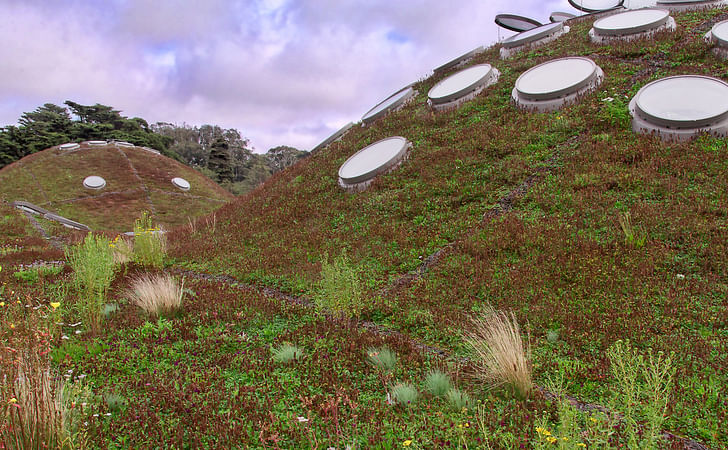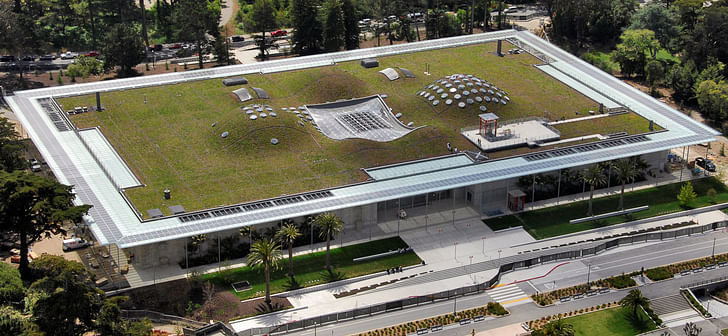

A masterful work of architecture, like a great symphony, relies not just on the vision of the conductor, but on the imagination of its individual players. Many highly-regarded buildings are the result of collaborations between architects and professionals from other disciplines who, on first glance, would have no business in an architectural studio. Yet it is often the interplay between these professionals' expertise and an architect's sensibility that creates noteworthy work.
Consider Renzo Piano's 2008 California Academy of Sciences, whose innovative sloping landscaped roof changed conceptions about the architectural possibilities of foliage. Plant life is an integral part of the design: the roof, which topographically mimics its host city of San Francisco, Kephart started drawing Egyptian-style mummies on bar napkins, which gave him the initial idea for the BioTrayboasts an innovative porous water and soil retention system known as a BioTray. Instead of the need for discrete planting containers, the flexible and ultimately biodegradable BioTray allows plant life to grow on almost any surface to which it is applied. Once visitors step out onto the viewing platform, they are drawn into the serenity of a highly specialized and visually arresting ecosystem, one which could not have come into being without the aid of ecologist Paul Kephart.

Explaining that he “studied and practiced botany, biology, and restoration ecology for 28 years” in order to apply those sciences to landscape design, Paul Kephart is distinguished primarily by his refusal to take direct paths – in life or in his thinking process. His unusual professional journey, which he described to me during a phone interview, seems to inform his creative professional problem-solving: he thrives on odd juxtapositions, and loves investigating how things function.

He began in the 1980s as an artistically-minded painter in Northern California before gradually "evolving" into an ecologist. One of his earliest paid gigs was helping Lucile and David Packard of the Packard Foundation do restoration work around their home. This involved founding the Elkhorn Native Plant Nursery and “developing and growing native grass seed and native plants for revegetation, range improvements, and urban ecology,” he explains. “I worked to restore 1,200 acres of land that had been in intensive agriculture for many years.” You tell an interesting story, but it also has to be beautiful"This experience prompted Kephart to shelve the canvases and in 1996 found Rana Creek, a full-service landscape architecture firm that has partnered with a variety of architects, including Renzo Piano, to create so-called living architecture installations.
So how does the relationship between a consultant and an architect work? As with any creative enterprise, its workings are as custom as the individuals it involves. In the case of the California Academy of Sciences, Kephart brought his focus on creating a functional and efficient botanical system into his relationship with Renzo Piano. Kephart had spent a year and a half compiling research and mock-ups for the roof design before he finally had the opportunity to show his work to Piano. After taking in Kephart's plans, which featured 29 different species of plant life as well as room for insects and hummingbirds, the architect said to Kephart: “You tell an interesting story, but it also has to be beautiful.”
This tussle between form and function ultimately created a gorgeous design that is also structurally impressive: Piano suggested that Kephart's elaborate drainage system should resemble "meandering streams" that would form a grid reminiscent of San Francisco's streets. Thanks to Piano's suggestions, each of the cluster of windows on the roof is not only counterbalanced atop their swelling mounds for maximum soil retention, but also because they form a kind of faux porthole-laden ship’s facade.

While the roof of the California Academy of Sciences is one of Kephart's most well-known works, it does not mark the first appearance of the BioTray. The BioTray originated in Switzerland over beers with friends after a hard day spent working on a “natural burial project” (i.e., bodies without coffins). In a playful mood, Kephart started drawing Egyptian-style mummies on bar napkins, which gave him the initial seed of the idea for the BioTray. The wrappings preserved the bodies inside; what if a horizontal “wrapping” could serve as a kind of flexible yet sustaining layer for plant life? “We should use our roofs for this,” he recalls thinking, and then began to seriously investigate the possibility of fitting roofs to create a container that would facilitate soil planting.
Paul Kephart is distinguished primarily by his refusal to take direct paths – in life or in his thinking processThe subsequent success of the California Academy of Sciences’ BioTray drew him into a working relationship with vertical garden enthusiast Patrick Blanc, whose living plant installations adorn buildings in Paris and Los Angeles. "I loved his vision from a botanical standpoint," Kephart says about Blanc, "and also his artistic approach to hydroponics."
Blanc, who became an honorary fellow of The Royal Institute of British Architects in 2009, collaborated with Kephart on a project to design a storm water recovery and living wall recirculation system to nourish one of Blanc’s vertical walls of plants— which Kephart, in a “fit of creative discontent” nicknamed the “rug on drugs.” He conceived of a closed loop reuse strategy that would organically retain and funnel the nutrients back into the main garden wall. Unfortunately, this closed loop strategy was value engineered out by the client.
Unlike a temporary installation or even a seasonal garden, Kephart's collaborations with architects are designed to perennially flourish. Kephart, who recently visited the California Science Museum, enjoys this dynamic. His initial 29 recommended species were eventually whittled down to only four for opening day; but over the years, he has returned to watch as the museum has slowly added more species to the rooftop. Kephart’s willingness to evolve has enabled architects to grow beyond their own limits of what “traditional” design allows.
Julia Ingalls is primarily an essayist. Her work has appeared or is forthcoming in Slate, Salon, Dwell, Guernica, The LA Weekly, The Nervous Breakdown, Forth, Trop, and 89.9 KCRW. She's into it.
No Comments
Block this user
Are you sure you want to block this user and hide all related comments throughout the site?
Archinect
This is your first comment on Archinect. Your comment will be visible once approved.